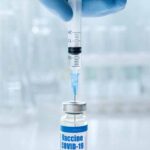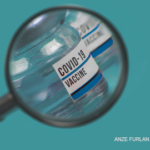Although a less central focus than it was three years ago, rheumatologists must still consider the prevention and management of SARS-CoV-2 in their patients. The following update shares ongoing considerations related to the COVID-19 pandemic.
Outcomes
At the beginning of the pandemic, it was unclear whether patients with rheumatic disease would be at higher risk of infection and poor disease outcomes than individuals in the general population, either through direct disease effects or indirectly via immunosuppressive therapies. Eventually, we learned the clinical severity of breakthrough infections and their overall rates were similar when comparing most rheumatic disease patients and healthy controls, with some important caveats.1
“It’s stratified based on the type of immune suppression, with B cell-depleting agents—potent immunosuppressives—like mycophenolate and high-dose prednisone really driving the highest risk for severe COVID and a greater risk of blunted immune responses,” says Alfred H. Kim, MD, PhD, assistant professor in the Division of Rheumatology at Washington University School of Medicine in St. Louis.
We’ve learned that specific early-onset responses to SARS-CoV-2 infection, such as interferons, are key in preventing severe disease. “The earlier antibodies are generated after infection, the more protection is observed in terms of preventing this progression to severe COVID-19,” says Dr. Kim. “The more potent the immunosuppressive, the greater the chance that an optimal response to the infection or vaccine won’t occur.”
Kevin Winthrop, MD, MPH, a professor of infectious diseases and professor of public health and preventive medicine in the Division of Infectious Diseases at Oregon Health and Science University, Portland, notes, “I think that for the rheumatologist, the most challenging group is people who have been on prolonged B cell-depletion [therapy]. Some are likely poorly protected because they didn’t mount vaccine responses that are adequate or long lasting.”
Vaccination
The data we’ve gained studying the immune response and outcomes in patients with rheumatic disease has informed ACR recommendations on the timing of SARS-CoV-2 vaccines and boosters and holding certain medications. Using these data and other preexisting data, particularly from H. influenzae, the ACR’s COVID-19 Vaccine Clinical Guidance Task Force provided recommendations, updated several times.2
Although certain medications, such as hydroxychloroquine, can be taken as usual before and after vaccination, others, such as Janus kinase (JAK) inhibitors, may need to be held one to two weeks after every vaccine or booster dose. For certain therapies, with less clear evidence, the task force did not come to a consensus about interrupting medications.2 Such recommendations are likely to continue to evolve.
The COVID-19 Clinical Guidance Task Force also recommends holding immunosuppressants in most circumstances for patients with active SARS-CoV-2 infection, regardless of COVID-19 severity, although this must be interpreted in the overall clinical context. Patients can take their therapies again one to two weeks after symptom resolution, or potentially later in patients recovering from severe COVID-19.3 Dr. Winthrop points out that this is similar to how he handles immunosuppressed patients who have infections from other causes.
Currently, no specific recommendations exist recommending COVID-19 boosters in immunosuppressed patients in addition to those recommended for the general population. However, Dr. Winthrop notes that one might consider giving an additional COVID-19 booster to specific patients, for example a patient on prolonged B cell-depleting therapy.
COVID Variants
New viral strains have brought somewhat different disease presentations and severity. Successful new strains often find ways to blunt patients’ immune responses, which have been shaped by earlier variants.
Dr. Kim notes that the omicron subvariants often present with primarily upper respiratory symptoms. Earlier variants of the SARS-CoV-2 virus were comparatively more prone to cause pneumonia. The incidence of multisystem inflammatory syndrome in children (MIS-C) has also dropped dramatically since the early days of the pandemic, perhaps due to decreased circulation of previous strains.
Hospitalization rates and mortality have substantially improved since the beginning of the pandemic, when older variants, such as delta, were more prominent. However, Dr. Kim points out that it is hard to tell for sure whether newer variants are truly less virulent. Improving hospitalization and mortality rates may be more a result of patients’ enhanced immunity from vaccination or previous SARS-CoV-2 infection.
Dr. Kim notes that because variants and preexisting population immunity are changing at the same time, it’s hard to define true causality. “I’m still not clear whether [this decreased virulence] can be extrapolated to the people we’re most concerned about, the patients on potent immunosuppression.”
The omicron BA.5 lineage had been dominant in the U.S. for months, but recently its descendants, BQ.1 (9.3% as of Jan. 28, 2023) and BQ1.1 (21.8%), have become more common. The most common SARS-CoV-2 variant circulating in the U.S. is XBB1.5 (61.3%), which has been becoming more widespread since December 2022. It is an offshoot of XBB (2.8%) and ultimately of the BA.2 omicron lineage.4
Both XBB and XBB.1.5 carry mutations in the spike protein that somewhat blunt the effectiveness of antibodies from vaccination or infection with earlier omicron strains. XBB1.5 appears to be more transmissible than other currently circulating variants, but no evidence has clearly indicated this will result in a surge in hospitalizations.5
Therapies
This changing variant landscape has dramatically altered treatment options for patients with acute SARS-CoV-2. “Nearly 90% of the circulating variants are resistant to available monoclonal therapies,” says Dr. Kim.
In 2022, the U.S. Food & Drug Administration (FDA) rescinded the use of four different monoclonal antibody products due to their ineffectiveness against commonly circulating variants: sotrovimab (Xevudy), bamlanivimab plus etesevimab, casirivimab plus imdevimab (REGEN-COV) and bebtelovimab. In January 2023 the FDA also rescinded the monoclonal product tixagevimab plus cilgavimab (Evusheld).
Many rheumatologists had been using Evusheld to provide pre-exposure prophylaxis for several months, particularly to more immunosuppressed patients. “Given that there’s no way to really prophylax people now, you’re left with making sure they’re up to date on the vaccine and treating them with anti-virals as soon as possible,” says Dr. Winthrop.
He employs nirmatrelvir packaged with ritonavir (Paxlovid) for most of his patients, noting molnupiravir is less effective, although he has used it in a handful of patients taking medications with severe drug–drug interactions with Paxlovid.
“I recommend anti-virals to everyone,” says Dr. Kim, “largely because the [Emergency Use Authorization] allows me to do that, and early data suggest that anti-virals do help reduce the chances of poor outcomes in immunosuppressed patients. Definitely for people who are doing poorly in the short term, we get it out to them as fast as we can.” He sometimes prescribes consecutive courses of Paxlovid to treat the rebound infections that can occur with it, “although we don’t have solid data about the benefits of this approach.”
Diversity & Equity Issues
The pandemic brought to light many preexisting health disparities. After making age-related statistical adjustments, Black, Hispanic and Indigenous Americans all have a higher risk of severe COVID-19 and mortality than white people in the U.S.6 The pandemic reduced life expectancy by more than two years for Black individuals in the U.S., obliterating—at least temporarily—the decade of process in narrowing the life expectancy gap between Black and white individuals.7
These minorities are about twice as likely to die from COVID-19 as white people of the same age. In terms of severe COVID-19 and mortality, these disparities have fluctuated over the course of the pandemic, with generally wider margins at times when the virus has surged.6
Although the reasons for these differences in health outcomes are complex, social determinants of health, including reduced access to social services and quality healthcare, socioeconomic factors, environmental factors influencing health behaviors, stressors and increased preexisting comorbidities may all play a role. Although COVID-19 highlighted these differences, these factors hugely influence outcomes across many disease categories.
Dr. Kim shares that he saw this reflected in his experience in St. Louis, a city with sharply demarcated socioeconomic and racial inequalities. “At least at WashU, the entire COVID experience has led us to have a much more concerted effort to understand the social determinants that drive health disparities.” He points out that it’s critical we come to understand these issues better, ideally identifying and implementing interventions that can help us better mitigate these disparities.
The history of racial injustice and patients’ negative experiences with culturally insensitive healthcare are one aspect of vaccine hesitancy in minorities.8 Asian and white adults had the highest COVID-19 vaccination rates by the end of April 2021, with lower rates in Hispanic, Black and Indigenous Americans. However, by the fall, coverage was similar for Black, Hispanic and white people by some estimates (78.2%, 81.3%, 78.7% respectively) although it remained lower for Indigenous Americans.9
This issue of vaccine hesitancy still looms large: About 80% of the total U.S. population has received at least one dose of vaccine, and about 68% completed a primary series. “Numerous groups are looking at this issue with high granularity, and I’ll be fascinated to see where we might have opportunities to both empathize with our patients’ concerns and fears about vaccination and educate them about the true risks and benefits of vaccination,” says Dr. Kim.
Looking Forward
Much uncertainty remains about how COVID-19 will continue to affect patient management. Dr. Kim explains that given recent input from the CDC, we should expect new COVID boosters to come out annually—despite the reduced mutational rate that SARS-CoV-2 possesses compared with other viruses like H. influenzae.
“Some subgroups of people, including some of our rheumatology patients, may need boosters more frequently than people in the general population,” says Dr. Winthrop. “We are still awaiting data to guide this decision making.”
Hopefully, effective monoclonal antibody treatments against newer omicron strains will soon be available for the most at-risk patients. AstraZeneca is engaged in the phase 1/3 Supernova trial for a new monoclonal antibody combination, AZD5156, which contains cilgavimab and a new long-acting monoclonal antibody, AZD3152.11
Dr. Winthrop emphasizes the importance of encouraging patients to complete their full vaccination schedule, including the most recent bivalent booster, which provides better protection against some omicron strains compared to earlier versions. He recommends making sure patients have rapid COVID tests at home and encouraging them to call the clinic so they can get anti-viral therapy promptly. Dr. Winthrop also encourages his most vulnerable patients to keep protective measures in place in some situations (e.g., masking on a plane flight).
Although the virus is still a risk that needs to be managed, it’s encouraging to see less severe outcomes overall compared with the earliest days of the pandemic. “Having more people with impactful functional immunity to any infectious disease is important, whether we call that herd immunity or not,” says Dr. Kim. “But at least in our system right now, the majority of our hospitalizations are still for patients with COVID.”
Ruth Jessen Hickman, MD, is a graduate of the Indiana University School of Medicine. She is a freelance medical and science writer living in Bloomington, Ind.
References
- Kim AHJ, Sparks JA. Immunosuppression and SARS-CoV-2 breakthrough infections. Lancet Rheumatol. 2022 Jun;4(6):e379–e380.
- COVID-19 vaccine clinical guidance summary for patients with rheumatic and musculoskeletal diseases. ACR. Version 5. Revised 2022 August 12.
- Mikuls TR, Johnson SR, Fraenkel L, et al. American College of Rheumatology guidance for the management of rheumatic disease in adult patients during the COVID-19 pandemic: Version 3. Arthritis Rheumatol. 2021 Feb;73(2):e1–e12.
- Centers for Disease Control and Prevention. Summary of variant surveillance. COVID data tracker. https://covid.cdc.gov/covid-data-tracker/#variant-summary. Accessed 2023 Jan 31.
- Callaway E. Coronavirus variant XBB.1.5 rises in the United States – is it a global threat?. Nature. 2023 Jan;613(7943):222–223.
- Hill L, Artiga S. COVID-19 cases and deaths by race/ethnicity: Current data and changes Over Time. Kaiser Family Foundation. 2022 Aug 22.
- Willis DE, Montgomery BEE, Selig JP, et al. COVID-19 vaccine hesitancy and racial discrimination among US adults. Prev Med Rep. 2022 Nov 28;31:102074.
- Hildreth JEK, Alcendor DJ. Targeting COVID-19 vaccine hesitancy in minority populations in the US: Implications for herd immunity. Vaccines (Basel). 2021 May 11;9(5):489.
- Kriss JL, Hung MC, Srivastav A, et al. COVID-19 vaccination coverage, by race and ethnicity – national immunization survey adult COVID module, United States, December 2020-November 2021. MMWR Morb Mortal Wkly Rep. 2022 Jun 10;71(23):757–763.
- Centers for Disease Control and Prevention. COVID data tracker weekly review. Accessed 2023 Jan 20.
- AstraZeneca. First participant dosed in SUPERNOVA PHASE I/III trial evaluating AZD5156, a next-generation long-acting antibody combination, for prevention of COVID-19. 2022 December 21.





